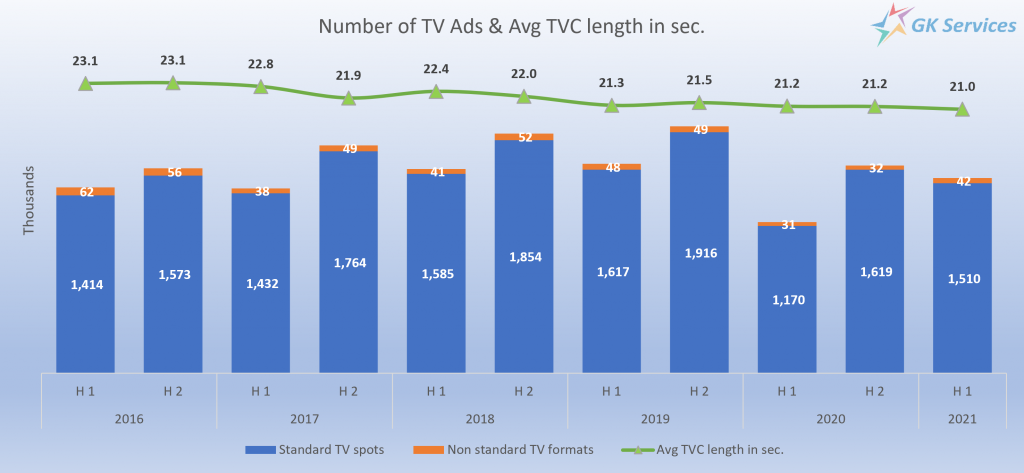2021 started with high expectations for a rapid market recovery. The shock of the first wave of the pandemic was followed by the transformation and adaptation of the business to the new reality. The fall months of 2020 proved this by quickly catching up with pre-Covid television activity levels. This fact strengthened the positive attitude and optimistic forecast for the coming 2021. In this topic we follow whether these expectations are about to be realized through a less commonly used indicator to study the dynamics of TV market – the number of broadcast commercials.
On the chart we present the broadcast number of TV commercials in thousands – standard spots (positioned in an ad blocks) and alternative ad formats (positioned outside an ad blocks) in the last five years, divided by semesters. In addition, we track the average length of ad formats during the reviewed period. The analyzed data include TV channels with constant advertising monitoring for the observed period. Thus we exclude possible distortion of the data related to the change in the number of monitored TV channels and ensure comparability of the data. The analyzed alternative ad forms do not include the teleshopping.

The first thing that makes an impression on the chart is that the advertising activity in the second half of the year is more intensive for each of the considered years. In 2020, this difference reaches its highest value, and the data show that 37% more advertising messages were broadcast compared to the first half of the year. One of the main reasons for this is the extraordinary epidemiological situation, which has stopped a number of campaigns and reality and entertainment TV formats. Given this feature of the annual dynamics of broadcast advertising, we compared the data for the first half of this year with the same period in 2020 to get an idea of the trend. The comparison shows that the quantity of ads broadcast in the first six months of 2021 exceeds by 29.1% the quantity of ads broadcast in the first half of the last year. Standard TV spots also increased by 29.0% and non-standard ad formats by 33.5%.
The result is in line with optimistic forecasts, but can we compare H1 2021 to pre-pandemic levels? The report shows that the first half of this year is still “catching up” with the results of the strong in terms of advertising 2019, reporting 6.8% fewer ads. There is also a lag of 4.5% when comparing the results with the first half of 2018, which means that the recovery of the advertising market will take longer.
The described conclusions can be supplemented with information about the share of alternative advertising forms. The figures show that 2016 was the most successful for alternative advertising reaching the highest percentage of total activity – 3.8%. Over the next three years, this share was relatively constant in the range of 2.6% ÷ 2.7%. In 2020, because of the pandemic, its share dropped to 2.2%. In January-June 2021, non-standard advertising forms increased again and returned to pre-pandemic level – 2.7% share of total TV ads.
From the presented graphics we can make a curious conclusion about the average length of the broadcast advertising messages. If in 2016 the average length is 23.1 seconds, then over the years it gradually decreases and for the first half of this year is already 21.0 seconds. One possible reason for advertisers to prefer shorter forms of advertising is the annual inflation in television advertising rate cards. Another likely reason for the reduction in the length of advertising messages is the global trend of reducing the time in which viewers remain focused on the content they watch.
For additional information, please contact our team via the contact form.

